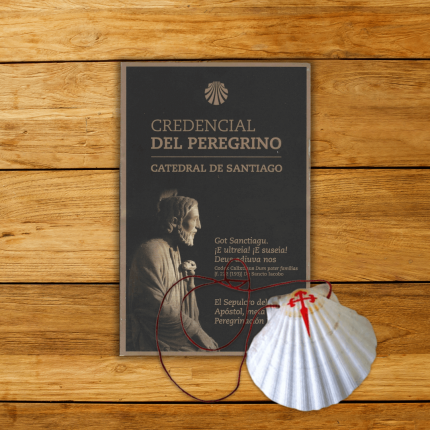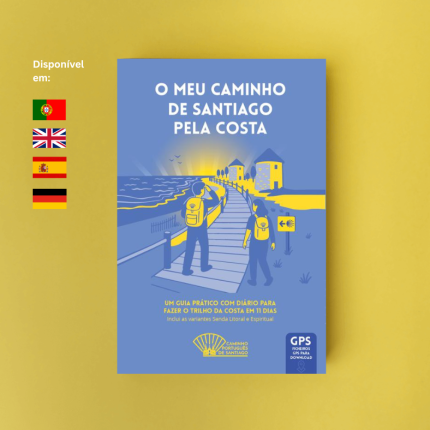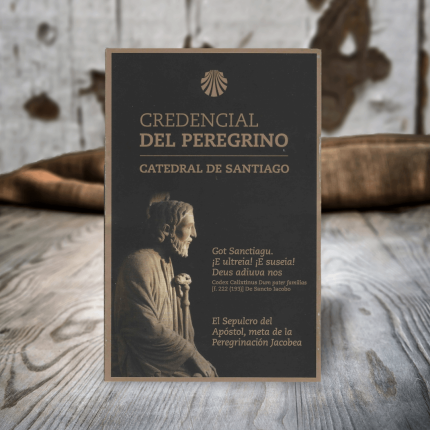How to prepare for the Camino de Santiago: complete training guide and practical tips

Estimated reading time: 10 minutes
If you are planning to do the Camino de Santiagothere's one essential step you shouldn't overlook: preparing for the Camino de Santiago physically and mentally. It's about 260 kilometers between Porto Cathedral and Santiago de Compostela on the Central Portuguese Way, and approximately 280 kilometers on the Coastal Route. Both routes have stunning landscapes, historic villages and challenging stages. The good news is that preparing for the Camino de Santiago isn't as difficult as it sounds. In fact, with a few weeks of training and adequate physical preparation, anyone can complete the route and live this unique experience without injury, pain or blisters.
Throughout this guide, we explain how to prepare for the Camino de Santiago step by step, with training plans, essential precautions and strategies for tackling the different types of terrain on the Central Portuguese Way and the Portuguese Coastal Way.
Contents
- 1. Why it's important to prepare for the Camino de Santiago
- 2. Training plan to prepare for the Camino de Santiago
- 3. How to prepare the Camino de Santiago for different types of terrain
- 4. Essential precautions when preparing for the Camino de Santiago
- 5. Plan the steps before you start
- 6. Last tip: prepare for the Camino de Santiago with realism and motivation
- 7. Frequently asked questions about preparing for the Camino de Santiago
1. Why it's important to prepare for the Camino de Santiago
Doing the Camino de Santiago is a profoundly transformative experience, but also physically demanding. The stages of the Central Portuguese Way and the Portuguese Coastal Way vary between 18 and 33 kilometers per day. In total, there are more than 250,000 steps spread over about two weeks of walking.
Without good physical and mental preparation, the longer stages can become exhausting and detract from the experience. That's why preparing for the Camino de Santiago means gaining endurance, strength and balance, but also training patience and mental focus.
The secret is to train progressively and consciously, adapting your body and mind to the cadence of the pilgrim. In short, the more you prepare before you set off, the more you'll be able to enjoy the walk and the contact with the route, the other pilgrims and yourself.
2. Training plan to prepare for the Camino de Santiago
The best way to prepare for the Camino de Santiago is to start early and consistently. You don't need to be an athlete: you just need to get into the habit of walking regularly, gradually increasing the distances and simulating the real effort of the stages.
It divides the preparation into three main phases, ideal for those who are going to walk the Central Portuguese Way or the Portuguese Coastal Way.
a. Stage 1: 5 kilometers without a backpack
It starts with light walks of 4 to 6 kilometers, three times a week. The aim is to awaken the body to movement and strengthen the joints. Walking in city parks, by the sea or in flat areas is enough at this stage.
This initial stage helps the body to gain rhythm and basic endurance, and the mind to associate walking with pleasure and routine. After that, a week to ten days is usually enough before you progress.
b. Stage 2: 10 kilometers with backpack
After the first few days of training, it's time to introduce the backpack. Ideally, you should simulate the weight you'll be carrying on the Camino (between 6 and 8 kg for most pilgrims).
Walk between 8 and 12 kilometers, two or three times a week, with regular breaks to hydrate. This phase helps to strengthen the back, shoulders and posture - essential points for those who are going to walk the Central Portuguese Way or the Coast, where there are areas of continuous ascent and descent.
Avoid training every day. Rest is part of preparation and allows the body to recover and evolve.
c. Stage 3: 15 to 20 kilometers over varied terrain
In the last phase, it brings training closer to the reality of the Camino de Santiago. You walk 15 to 20 kilometers on a variety of terrain: road, trail, uphill and downhill. If possible, train in places with uneven terrain and moderate gradients.
The aim is to simulate a typical day on pilgrimage. Include short breaks, test out the shoes and the final backpack, and observe how your body reacts. By now, you should feel confident enough to tackle the daily stages of between 20 and 30 kilometers.
3. How to prepare the Camino de Santiago for different types of terrain
During the Portuguese Camino de Santiagoalong both the Central Way and the Coast, you'll encounter a wide variety of terrain: asphalt roads, dirt tracks, forest areas and trails with steep gradients.
Training on different surfaces is one of the best ways to prepare for the Camino de Santiago, as it helps to strengthen different muscles, improves balance and teaches the body to adapt to each type of surface.
a. Paved roads
They are most common on the way out and in. The impact on the joints is greater, so wear shoes with good absorption and flexible soles. Always walk on the left-hand side of the road to see approaching cars and keep your eyes on the traffic. Avoid earphones and visual distractions.
b. Dirt tracks
This type of surface is predominant on the Portuguese Camino de Santiago. They are comfortable stretches, but can have little grip on rainy days. Walk with a firm stride, avoid wearing slippery shoes and watch out for small stones or roots.
Training on this type of terrain is essential for strengthening ankles and improving body stability.
c. Mountain trails and gradients
Areas with climbs and descents require strength, balance and good technique. Practice long climbs and steep descents to prepare your knees and ankles. If you have walking poles, use them: they help relieve the impact and distribute the effort between your arms and legs.
Training on uneven terrain also strengthens the stabilizer muscles, reducing the risk of injury during the Camino.
4. Essential precautions when preparing for the Camino de Santiago
Preparing for the Camino de Santiago goes beyond training. It's also about taking care of your body, your equipment and your mind. The following precautions will make all the difference to your experience as a pilgrim.
a. Prevents blisters and sores on the feet
Blisters are the main cause of pain and abandonment on the Camino. They result from friction between the skin and the shoe. To avoid them:
- Wear technical, seamless socks made of breathable fabric.
- Always train in the shoes you're going to wear on the Camino.
- Never wear sneakers or boots during the pilgrimage.
- Moisturize your feet well after each workout and dry them before putting on socks.
If blisters still appear, treat them quickly with hydrocolloid dressings and don't pop them unnecessarily.
b. Take care of your body and mind
Sleeping well and eating properly are just as important as physical training. Walking every day consumes a lot of energy, so make sure you eat a balanced diet and stay hydrated.
It also trains the mind. After all, repetition, silence and time with yourself are all part of the experience. The ability to stay focused and calm is what distinguishes a prepared pilgrim from a tired one.
5. Plan the steps before you start
One of the best ways to prepare for the Camino de Santiago is to know the stages in advance. On our website you'll find a full description of the stages of the Central Portuguese Way and the Portuguese Coastal Way, including distances, average duration, type of terrain and level of difficulty.
With this information, you can adapt your training to reality: if a stage has a lot of climbs, prioritize incline training; if it's flatter, work on endurance and pace.
Also plan your breaks, accommodation and logistics. This reduces stress and allows you to concentrate on the essential: walking.
6. Last tip: prepare for the Camino de Santiago with realism and motivation
O Camino de Santiago is a demanding but deeply rewarding journey. Preparing for the Camino de Santiago is, in itself, the beginning of the pilgrimage. Every workout, every walk and every choice is part of the journey.
Don't compare yourself to other pilgrims. Each Camino is personal. Walk at your own pace, respect your body and enjoy each stage - whether it's the Central Portuguese Way, with its villages and valleys, or the Portuguese Coastal Way, by the sea.
The most important thing is to arrive in Santiago with the feeling that you've experienced the Camino in its entirety.
7. Frequently asked questions about preparing for the Camino de Santiago
It depends on your physical condition. On average, four to eight weeks of training is enough for those who already do some exercise. If you have a sedentary lifestyle, start three months before departure.
No. The ideal is to train three to four days a week, alternating with rest. The body needs time to adapt and strengthen.
It's not compulsory, but it can help. Strength and balance exercises - especially for the legs, back and abdominals - improve posture and reduce the risk of injury during long stages.
It depends on personal preferences and the time of year. Lightweight hiking shoes or trekking boots are ideal. The main thing is that they are comfortable and already worn during training.
Yes, training with the same weight and type of backpack as you're carrying is essential. This way the body adapts to the real effort and avoids back and shoulder pain during the Camino.
Best-selling products
-
Credential Kit + Pilgrim's Shell
10,00 € -
Portuguese Coastal Path Guide - PRE SALE
22,00 € -
Pilgrim Credential
5,00 € -
My First Path" kit
The original price was €32.00.27,00 €The current price is: €27.00. -
My Camino de Santiago" guide
22,00 €

Since 2018, we have accompanied thousands of pilgrims with content, guides and experiences that help them prepare for the Camino de Santiago and live it in a simpler and more inspiring way. Over the years we have created a space for sharing and mutual help that continues to grow every day. Today we run the largest digital community on the Portuguese Camino de Santiago, with more than 110,000 pilgrims and future walkers. This is where we share tips, stories and practical information and where we also learn about the main doubts and challenges faced by those who dream of reaching Santiago.






I really want to do this Portuguese route between Porto and Santiago de Compostela, but I don't want to do it alone. Is there an interactive agenda where I can join a group? I've already done the 310 km between Águas da Prata and Aparecida and thanks to the interactive agenda I've joined up with three other people.
Great warnings. I'll incorporate them into my preparation practices.
Great tips! I've been hiking for 30 days and this past week I did 20km with my backpack on. I'm starting my hike on May 21, so I hope all the preparation has been enough!
Good afternoon,
I intend to do the route from Braga on June 10, can you help me with a plan that allows me and my wife to do the route and our luggage to be transported by you to the accommodation?
Regarding accommodation, we intend to stay in hotels in a single room with bathroom, with dinner and breakfast, do you also provide this service?
thank you for your cooperation.
thank you, Luis Ferreira
I want to receive information
Travel planning
Excellent tip. I would only add that you should buy waterproof sneakers or boots. I completed this route on June 11/22 and during the rain, my feet got wet and gave me blisters. If possible, buy waterproof shoes and wear them when you train so that they mold to your feet. The rest is enjoy your time and Buen Camino !!!
Good afternoon
I would very much like to do the route, but it has to be from the city of Guarda to Santiago. Is there a route you can give me and more information?
Is there a group that does the route?
Thank you